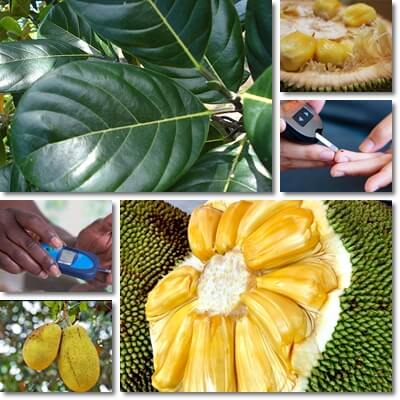The glossy, leathery, dark green leaves of the jackfruit (Artocarpus heterophyllus) are the part of the fruit not normally consumed, but still a source of important health benefits. One of the most notable health effects is the anti-diabetic action of the leaf extract in the form of reduced blood sugar post-meal and better glucose tolerance in both diabetics and non-diabetics. Further cholesterol-lowering properties have been observed, with direct benefits for cardiovascular health, an important aspect of diabetic health.
What do jackfruit leaves look like?
The mature leaves of the jackfruit, which studies show hold the highest anti-diabetic potential, are egg-shaped and elongated, with a broad base (where the leaf is attached to the stem via a petiole/stalk) and pointy towards the tip.
They have one main vein going from the base to the tip and multiple thinner lateral veins stemming from it and smooth edges. The leaves are dark green in color, except for the veins which are a lighter, green-yellow color, and rather thick or meaty, glossy-looking with a leathery texture.

Studies have shown that water and alcohol extracts of the mature leaves hold multiple health benefits, notably antibacterial, antifungal, anti-arthritis, wound healing, anti-carcinogenic and especially anti-diabetic activity.
In fact, the jackfruit itself is wrongfully attributed anti-diabetic activity when, in fact, it is the leaves that exhibit such health effects. According to research, both diabetics and healthy individuals may benefit for the hypoglycemic activity of the leaf extracts.
Normally, jackfruit leaves are not eaten and not even considered edible. For the most part, their culinary use is limited to wrapping food that is being cooked (steamed). However, in some cultures, the young, tender leaves are used as culinary vegetables and occasionally consumed cooked. The mature leaves are only used as livestock feed. However, they have been used in traditional medicinal systems to treat various ailments, including diabetes and associated health issues (external use).

What are the benefits of jackfruit leaves for diabetes?
Currently, extracts of the mature leaves have been considered for diabetes treatment due to providing significant benefits for wound healing, better blood sugar control and glucose tolerance, reduced insulin resistance and healthier cholesterol and triglyceride values.
1) Lower blood sugar (hypoglycemic effects)
Water and alcohol-based extracts of mature jackfruit leaves have been found to have significant hypoglycemic effects, reducing blood sugar levels post-meal. Animal studies were carried out on both normoglycemic rats and streptozotocin-induced diabetic rats and results showed important blood-sugar lowering effects of both extracts.
The water-based leaf extract reduced blood sugar by 28.7% 2 hours following administration, while the ethyl acetate-based extract by 42.5%. The active ingredients responsible for the marked hypoglycemic activity of the leaf extract are theorized to be of flavonoid origin (antioxidants). The flavonoids exhibited higher solubility in the ethyl acetate, hence the reason why the second leaf extract produced more significant hypoglycemic effects compared to the first.
For further information see the study below:
Evaluation of the hypoglycemic and hypolipidemic effects of an ethyl acetate fraction of Artocarpus heterophyllus (jak) leaves in streptozotocin-induced diabetic rats. Pharmacogn Mag. 2010 Jul-Sep; 6(23): 186–190.
2) Improved glucose tolerance
As a result of its blood sugar-lowering effects, jackfruit leaf extract (both water and ethyl acetate-based) helps improve tolerance to glucose, according to animal studies carried out on diabetic and non-diabetic rats. The leaf extract has been shown to improve glucose tolerance in human subjects as well.
3) Jackfruit leaves and their wound healing activity
Traditionally, jackfruit leaves were applied to ulcers and other kinds of wounds with the purpose of promoting healing (either alone or in combination with other elements).
Various folk medical systems employed the leaves for wound healing in the form of leaf ashes, heated, boiled leaves or paste of fresh leaves that was applied to the wound.
Studies show the benefits for wound healing are owed to antibacterial, antifungal, anti-inflammatory, analgesic and immuno-modulating constituents and extracts of the leaves are being considered for the faster treatment of diabetes-associated wounds such as poorly-healing ulcers.
Flavonoids such as morin (also found in bilberry and white mulberry wood), artocarpesin and artocarpanone have important anti-inflammatory and antibacterial properties. Artocarpanone has been found to be effective against Escherichia coli, while extracts of arocarpesin showed bactericidal activity against Staphylococcus aureus.
Methanol-based jackfruit leaf extract was shown to have wound healing activity comparable to Betadine. Ethyl acetate jackfruit leaf extract was further shown to promote skin repair as a result of both flavonoid constituents and triterpenoids such as ursolic acid. The constituents promoted wound contraction, faster skin regeneration whilst exerting antimicrobial effects, all of which contribute to improved wound healing. Essential trace minerals found in the extract (zinc, manganese, copper and iron) further helped the process by supporting cell growth and replication.
4) Hypolipidemic effects – lower cholesterol
Animal studies show jackfruit leaf extracts can lower cholesterol and triglyceride levels in both normoglycemic rats and streptozotocin-induced diabetic rats.
Both the water and ethyl acetate extracts lowered cholesterol and triglyceride levels in non-diabetic rats which could mean the leaf extracts contribute to a reduction in diabetes risks.
However, in streptozotocin-induced diabetic rats, the water-extract increased cholesterol and triglycerides, whereas the ethyl acetate one reduced values.
Better cholesterol and triglyceride numbers could mean reduced insulin resistance and lead to better diabetes management.
Important take-away:
- The mature leaves and not the edible jackfruit are the source of benefits for diabetes.
- Their anti-diabetic benefits are proven and significant in nature, but no treatment has been formulated yet.
- Currently, anti-diabetic effects can only be replicated through the use of specially-formulated extracts and not in humans (at least not without side effects). As such, it is not advised to consume the mature leaves. There are safety concerns, notably the leaves containing alkaloid and glycoside compounds which could elicit side effects in case of ingestion.
- There is still much to be learned about the mechanism of action of jackfruit leaves on diabetes and their use for the treatment of the metabolic condition remains to be regulated.
